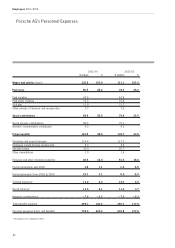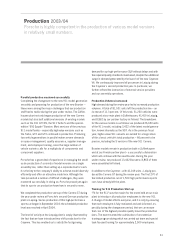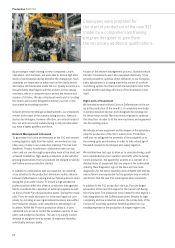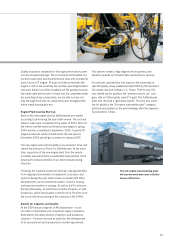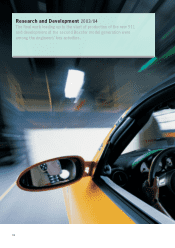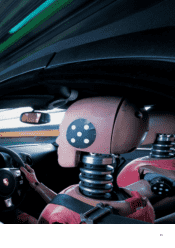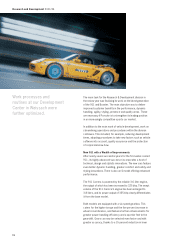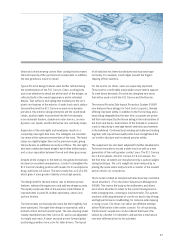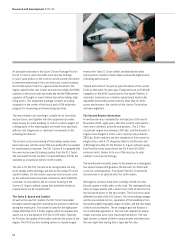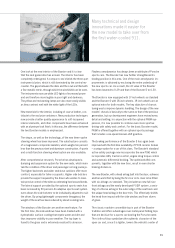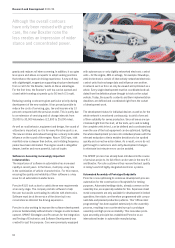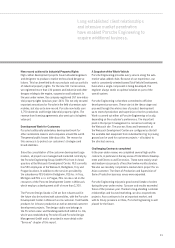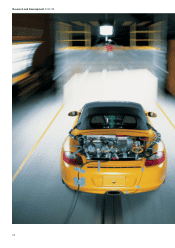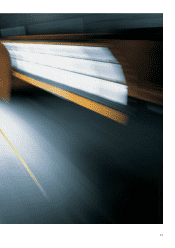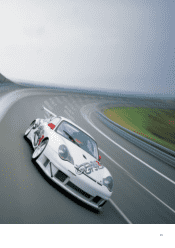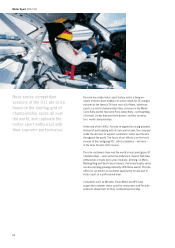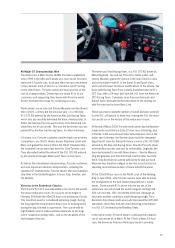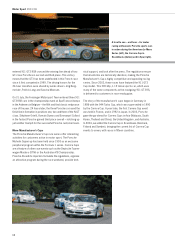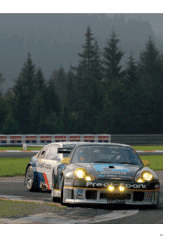Porsche 2003 Annual Report Download - page 94
Download and view the complete annual report
Please find page 94 of the 2003 Porsche annual report below. You can navigate through the pages in the report by either clicking on the pages listed below, or by using the keyword search tool below to find specific information within the annual report.
90
gravity and reduces roll when cornering. In addition, it occupies
less space and allows occupants to adopt seating positions
that enhance the open-air driving experience. A new soft top,
with a lightweight, magnesium supporting structure developed
from scratch for the Boxster, builds on these advantages.
For the first time, the Boxster’s soft top can be opened and
closed while traveling at speeds up to 50 km/h (31 mph).
Reducing running costs were given particular priority during
development of the new roadster. It has proved possible to
reduce the costs of servicing, gas, tax und insurance by 13
percent compared with the previous model. This is partly due
to an extension of servicing and oil change intervals from
20,000 to 30,000 kilometers (12,500 to 25,000 miles).
As well as road behavior, equipment and design, the sound of
a Boxster is important, as it is for every Porsche sports car.
The new air intake and exhaust tuning has a clearly noticeable
influence on the sound of the engine. Above 3000 rpm, inlet
manifold noise is deeper than before, and irritating frequency
peaks have been eliminated. The engine sound is altogether
deeper, beefier and more powerful, but not louder.
Software is becoming increasingly important
in Automobiles
The importance of software in automobiles has increased
rapidly in recent years. In the future, it will play a key role
in the optimization of vehicle characteristics. For this reason,
ensuring the quality and reliability of their software is a key
issue for all automobile manufacturers.
Porsche R & D took action to satisfy these new requirements
at an early stage. The company installs software to help
the user but avoids overloading its vehicles with electronics.
Software must be at the service of the driver but in no
circumstances diminish the driving experience.
Porsche is also working to improve the software development
process fundamentally without drastic changes in vehicle devel-
opment. SPRINT (Strategies and Processes for the Integration
and Testing of Electronics and Software Development) was
created for just this purpose. Cars were previously equipped
with autonomous or only slightly networked electronic control
units – for the engine, ABS or airbags, for example. Nowadays,
vehicle electronics consist of interactively networked electronic
control units that exchange data and influence one another.
A network such as this can only be viewed and optimized as a
whole. Every single development must be coordinated and vali-
dated from the definition phase through to trials on the actual
vehicle. Today, the specific contents and their implementation
deadlines are defined and coordinated right from the outset
of development work.
The development status for individual devices as well as for the
whole network is monitored continuously, to yield a forecast
of their suitability for series production. Since all areas are syn-
chronized right from the start, all the tests, up to and including
the complete vehicle test, can be defined and coordinated and
even the use of the test equipment can be optimized. Splitting
the whole development process into individual phases with the
relevant evaluation criteria enables deviations to be spotted
quickly and corrective action taken. As a result, errors do not
get through to customers and costly development changes
to eliminate last-minute errors can be avoided.
The SPRINT process has already been introduced in the course
of previous projects. Its full effect can be seen in the new 911
and Boxster. Porsche customers thus receive the best quality
in today’s world of highly integrated electronic systems.
Automated Assembly of Prototype Bodyshells
Porsche is now optimizing its extensive development-process
automation for the construction of bodyshells for testing
purposes. Automated welding robots, already common on the
assembly line, are especially suitable for this. Expensive sheet
metal components are only available for development in limited
quantities; the robots are therefore programmed with compo-
nent data and planned production patterns. This “offline robot
programming” has been applied extensively to the assembly
process, resulting in an accelerated run-up to prototype
assembly and high process reliability. This innovative proto-
type assembly principle has established Porsche as an
international leader in automobile manufacturing.
Research and Development 2003 ⁄ 04
Although the overall contours
have only been revised with great
care, the new Boxster none the
less creates an impression of wider
stance and concentrated power.


